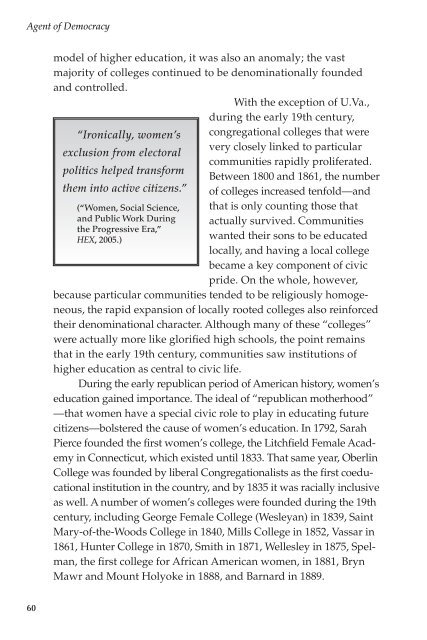Agent of Democracy - Society for College and University Planning
Agent of Democracy - Society for College and University Planning
Agent of Democracy - Society for College and University Planning
You also want an ePaper? Increase the reach of your titles
YUMPU automatically turns print PDFs into web optimized ePapers that Google loves.
<strong>Agent</strong> <strong>of</strong> <strong>Democracy</strong><br />
model <strong>of</strong> higher education, it was also an anomaly; the vast<br />
majority <strong>of</strong> colleges continued to be denominationally founded<br />
<strong>and</strong> controlled.<br />
With the exception <strong>of</strong> U.Va.,<br />
during the early 19th century,<br />
“Ironically, women’s<br />
exclusion from electoral<br />
politics helped trans<strong>for</strong>m<br />
them into active citizens.”<br />
(“Women, Social Science,<br />
<strong>and</strong> Public Work During<br />
the Progressive Era,”<br />
HEX, 2005.)<br />
congregational colleges that were<br />
very closely linked to particular<br />
communities rapidly proliferated.<br />
Between 1800 <strong>and</strong> 1861, the number<br />
<strong>of</strong> colleges increased tenfold—<strong>and</strong><br />
that is only counting those that<br />
actually survived. Communities<br />
wanted their sons to be educated<br />
locally, <strong>and</strong> having a local college<br />
became a key component <strong>of</strong> civic<br />
pride. On the whole, however,<br />
because particular communities tended to be religiously homogeneous,<br />
the rapid expansion <strong>of</strong> locally rooted colleges also rein<strong>for</strong>ced<br />
their denominational character. Although many <strong>of</strong> these “colleges”<br />
were actually more like glorified high schools, the point remains<br />
that in the early 19th century, communities saw institutions <strong>of</strong><br />
higher education as central to civic life.<br />
During the early republican period <strong>of</strong> American history, women’s<br />
education gained importance. The ideal <strong>of</strong> “republican motherhood”<br />
—that women have a special civic role to play in educating future<br />
citizens—bolstered the cause <strong>of</strong> women’s education. In 1792, Sarah<br />
Pierce founded the first women’s college, the Litchfield Female Academy<br />
in Connecticut, which existed until 1833. That same year, Oberlin<br />
<strong>College</strong> was founded by liberal Congregationalists as the first coeducational<br />
institution in the country, <strong>and</strong> by 1835 it was racially inclusive<br />
as well. A number <strong>of</strong> women’s colleges were founded during the 19th<br />
century, including George Female <strong>College</strong> (Wesleyan) in 1839, Saint<br />
Mary-<strong>of</strong>-the-Woods <strong>College</strong> in 1840, Mills <strong>College</strong> in 1852, Vassar in<br />
1861, Hunter <strong>College</strong> in 1870, Smith in 1871, Wellesley in 1875, Spelman,<br />
the first college <strong>for</strong> African American women, in 1881, Bryn<br />
Mawr <strong>and</strong> Mount Holyoke in 1888, <strong>and</strong> Barnard in 1889.<br />
60

















